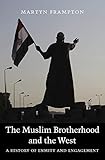The Muslim Brotherhood and the West : A History of Enmity and Engagement / Martyn Frampton.
Material type: TextPublisher: Cambridge, MA : Harvard University Press, [2018]Copyright date: ©2018Description: 1 online resource (672 p.)Content type:
TextPublisher: Cambridge, MA : Harvard University Press, [2018]Copyright date: ©2018Description: 1 online resource (672 p.)Content type: - 9780674984912
- 322.4/2 23
- BP10.I385 F73 2018eb
- online - DeGruyter
| Item type | Current library | Call number | URL | Status | Notes | Barcode | |
|---|---|---|---|---|---|---|---|
 eBook
eBook
|
Biblioteca "Angelicum" Pont. Univ. S.Tommaso d'Aquino Nuvola online | online - DeGruyter (Browse shelf(Opens below)) | Online access | Not for loan (Accesso limitato) | Accesso per gli utenti autorizzati / Access for authorized users | (dgr)9780674984912 |
Browsing Biblioteca "Angelicum" Pont. Univ. S.Tommaso d'Aquino shelves, Shelving location: Nuvola online Close shelf browser (Hides shelf browser)

|

|

|

|

|

|

|
||
| online - DeGruyter Not Enough : Human Rights in an Unequal World / | online - DeGruyter Leftism Reinvented : Western Parties from Socialism to Neoliberalism / | online - DeGruyter Information, Incentives, and Education Policy / | online - DeGruyter The Muslim Brotherhood and the West : A History of Enmity and Engagement / | online - DeGruyter Bring the War Home : The White Power Movement and Paramilitary America / | online - DeGruyter What Was Literary Impressionism? / | online - DeGruyter What Is China? : Territory, Ethnicity, Culture, and History / |
Frontmatter -- Contents -- Note on Transliteration and Spelling -- Introduction -- PART I. In the Shadow of Empire -- Origins and First Encounters 1928–1939 -- Wartime Liaisons 1940–1944 -- Best of Enemies 1944–1949 -- The War of the Canal Zone 1950–1952 -- PART II. In the Age of America -- The Upheavals of Revolution 1952–1954 -- The Age of Nasser 1955–1970 -- Reassessments amid the “Fundamentalist” Revival 1970–1989 -- Blurred Lines and New Debates 1989–2010 -- Conclusion -- Notes -- Acknowledgments -- Index
restricted access online access with authorization star
http://purl.org/coar/access_right/c_16ec
The Muslim Brotherhood and the West is the first comprehensive history of the relationship between the world’s largest Islamist movement and the Western powers that have dominated the Middle East for the past century: Britain and the United States. In the decades since the Brotherhood emerged in Egypt in the 1920s, the movement’s notion of “the West” has remained central to its worldview and a key driver of its behavior. From its founding, the Brotherhood stood opposed to the British Empire and Western cultural influence more broadly. As British power gave way to American, the Brotherhood’s leaders, committed to a vision of more authentic Islamic societies, oscillated between anxiety or paranoia about the West and the need to engage with it. Western officials, for their part, struggled to understand the Brotherhood, unsure whether to shun the movement as one of dangerous “fanatics” or to embrace it as a moderate and inevitable part of the region’s political scene. Too often, diplomats failed to view the movement on its own terms, preferring to impose their own external agendas and obsessions. Martyn Frampton reveals the history of this complex and charged relationship down to the eve of the Arab Spring. Drawing on extensive archival research in London and Washington and the Brotherhood’s writings in Arabic and English, he provides the most authoritative assessment to date of a relationship that is both vital in itself and crucial to navigating one of the world’s most turbulent regions.
Mode of access: Internet via World Wide Web.
In English.
Description based on online resource; title from PDF title page (publisher's Web site, viewed 24. Aug 2021)


